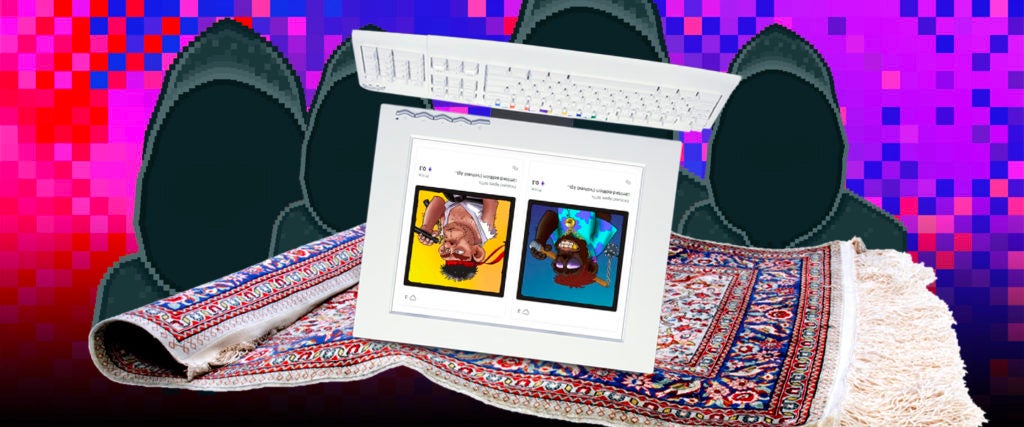Just as it ravaged other cultural industries, the coronavirus outbreak had a punishing and immediate effect on the art market. In 2020, the sector shrank 22 percent, from sales of $64.4 billion to $50.1 billion. Yet some critics were relieved, saying this was a welcome correction in a business where prices have become wildly inflated. Meanwhile, with auctions forced to go online, the global customer base expanded, with new and lapsed collectors entering the scene.
With the shift to virtual spaces, the appetite for contemporary art had a particularly strong rebound, breaking records with $2.7 billion in sales between June of 2020 and June of this year. Among the hottest commodities were pieces that translate well to digital format, like photos — but accounting for a full third of those sales were “completely dematerialised artworks” known as NFTs, or non-fungible tokens. These are files, often images or videos, which can be bought with cryptocurrencies (usually Ethereum). Although the files themselves are endlessly reproducible, ownership of the “original” is verified by a public transaction record in the blockchain database.
NFTs are also, it would seem, uniquely tailored to what’s called a “rug pull” scheme.
Back in December 2020, a developer and NFT skeptic named James Prestwich (@_prestwich) demonstrated the art of the rug pull at its simplest. First, he tweeted: “buying tweets is cargo cult ownership for rubes who want to simp crypto twitter influencers.” Eli Krenzke (@eKRENZKE), clearly not without a sense of irony, minted that tweet as an NFT through the platform Cent and offered to purchase the “signed” artifact from Prestwich, who sold it to him for a little over 1 ether, or $639 at the time. (The same amount is worth about $3,472 as of this writing.)
Next, Prestwich simply deleted his tweet, leaving Krenzke only with the proof that he owned something which no longer existed. Cent tried to make amends months later, noting that they had since implemented screenshots in their NFTs in order to prevent this. But all in all, this looks to have been a harmless prank among friendly parties — and Krenzke said he would hang on to the rugged NFT. After all, it now had an even more interesting history, which could add to its value. In turn, Twitter user @SLVTRMNDI minted and sold their tweet with a screenshot of the rug pull on Cent for 0.0145 ether, currently about $50. Although Prestwich’s “scam” was intended to demonstrate the hazards of NFT investing, it generated further dividends.
In March, an artist with the Twitter handle @neitherconfirm executed a rug pull on OpenSea, the largest NFT market, converting all the images in their collection up for auction to pictures of literal rugs. In an ensuring thread, they used the stunt to argue that NFTs are without value unless the token — that is, your certificate of ownership — is “inseparable from the artwork itself.” If an NFT is reliant on a centralized service that someone else controls, they argued, you don’t own anything.
But such warnings appear to have inspired another iteration of the game: NFT sets that lean into the scammer aesthetic. There’s “Rug Pull: An NFT Experience,” a website where you can mint one of 6,969 “hand-painted” rugs for 0.2 ether apiece, and supposedly gain “exclusive access to support groups for victims of previous rug pull projects.” Or maybe you’d be into “Rug Pull Frens,” described as the “cutest robbery gang in the Metaverse consisting of 10,000 cute, yet potentially killer animals in the ethereal world.” Pouring your money into such assets would be like buying stock in a company called Pump & Dump Inc., except in this case, if you’re left holding the bag, the SEC is powerless to investigate.
Most recently, a creator known as “Evil Ape” made off with $2.7 million ether that collectors spent on their “Evolved Apes” series, a highly derivative bunch of cartoon primates designed — as many NFTs are of late — to serve as avatar images. The heist, while significant, was hardly unique; two other recent pulls added up to $2.5 million in losses. Once more, however, a swindle has led to further activity. Not only, as VICE reports, can you still trade the Evolved Apes on OpenSea, giving the fraudster Evil Ape a 4 percent commission with each purchase, but other NFT creators have swooped in to offer anyone burned a chance… to purchase their NFTs. After losing out, many victims are willing and eager to risk the exact same kind of speculation.
This irrational decision can be chalked up to the “sunk-cost fallacy,” or the human tendency to “throw good money after bad” — we’re already down, so we escalate our commitment in hopes that by maintaining consistent behavior, we’ll end up ahead. NFTs add an insidious social layer to this phenomenon, as popular, themed collections promise a “community” of owners. You’re not just spending crypto on pixels, you’re joining a theoretically close-knit fandom or club. Disillusionment with a group that collapses when the mastermind vanishes along with all the coin might leave you vulnerable to another clique that voices sympathy for your situation. After being a mark, you’re desperate to trust again. As long as this mindset endures, the NFT scams will be self-perpetuating.
My advice? Buy a cheap van Gogh print for your living room instead.

